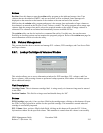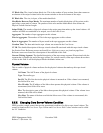volume.
• In DOWN condition, the volume cannot be read, written or mounted. This condition can be used
to make a disk unavailable to the system.
Change the VV Condition of a disk virtual volume by selecting the desired condition from the drop
down menu and then pressing the Update button.
Changes Pending. If there are any VV Condition changes for this volume pending in the Core server,
Changes Pending will be "Yes" with a red bullet. Otherwise, Changes Pending will be None.
Retired. When checked, the volume is retired. New storage segments will not be created on the volume.
More Commonly Used Data Tab
Number of Extents. The number of disk storage segment extents allocated in this virtual volume.
Storage Class. The storage class to which the disk virtual volume is assigned.
Storage Map Flags. Normally this field is blank, but if "Offline" is displayed in this field, the disk
volume is not available for use because the PVL mount job failed. The Core Server received an error
when it tried to mount one or more of the disks in the volume the last time it started. Accesses to the disk
will receive an error. New storage segments will not be created on the disk. The volume can be brought
back on-line only by correcting the mount problem and restarting the Core Server. If more than one of the
underlying physical volumes is off-line, the virtual volume will remain off-line until all physical volumes
are on-line
Usable Length. The amount of disk space that can be used for storing storage segments. This is the
Actual Length of the disk volume minus certain amounts set aside for system use.
Free Space. The number of bytes on the disk virtual volume that are not assigned to storage segments.
Free Space is initially set to the value of Usable Length, then decremented and incremented by the size of
disk storage segments as they are created and deleted. Since disk storage segments are allocated in whole
Clusters, they are usually larger than the amount of storage needed to store the segment of the file. This
creates “slack space” which is space allocated to files, but not filled with file data. The amount of disk
space in use for any volume, which is the Usable Length minus the Free Space, will always be somewhat
greater than the sum of the lengths of the file segments stored on the volume. Since unallocated disk
space may become fragmented, it may not be possible to create new disk storage segments on a volume
even if the amount of Free Space appears to be large. The size of the largest free extent on the volume is
logged by the Core Server when this happens.
Stripe Width. The number of physical volumes in the stripe group that makes up the virtual volume. All
volumes in HPSS are considered to be striped, even if this value is one.
Time Last Read. The date and time the volume was last read. This value is not stored in metadata, but is
initialized to zero when the Core Server starts and then updated each time the disk is read. This field is
not affected by transaction aborts.
Time Last Written. The date and time the volume was last written. This value is not stored in metadata,
but is initialized to zero when the Core Server starts and then updated each time the disk is written. This
field is not affected by transaction aborts.
PVL Job ID. The PVL job ID in which this volume is mounted. This field will be zero if the volume is
not mounted.
HPSS Management Guide November 2009
Release 7.3 (Revision 1.0) 271


















